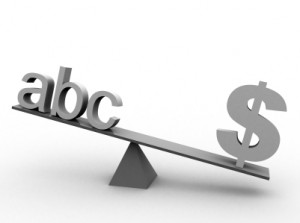Five Lessons from PayScale’s College “Return on Investment” Data
For the past month the Internet has been abuzz over the PayScale study that attempts to quantify the value of a college degree. Francesca Di Meglio, writing for Bloomberg BusinessWeek.com backed a position that is now seeing growing national support: College: Big Investment, Paltry Return.
Di Meglio notes the general theory that has seemingly been expounded at every turn in recent months:
“Over the past decade, research estimates have pegged that figure at $900,000, $1.2 million, and $1.6 million” but “the value of a college degree may be a lot closer to $400,000 over 30 years.”
She notes that the amount “varies wildly from school to school” but that there are “only 17 schools in the study whose graduates can expect to recoup the cost of their education and out-earn a high school graduate by $1.2 million. At more than 500 other schools, the return on investment, or ROI, is less—sometimes far less.”
 Not too surprisingly, many of the most expensive, private colleges do in fact produce outstanding return on investment or ROI (see accompanying chart of the top 10). Whether it is MIT, Notre Dame, Harvard, Harvey Mudd, Dartmouth, Princeton or Stanford, students completing a bachelor’s degree program at these elite schools can expect rates of return topping 12 percent.
Not too surprisingly, many of the most expensive, private colleges do in fact produce outstanding return on investment or ROI (see accompanying chart of the top 10). Whether it is MIT, Notre Dame, Harvard, Harvey Mudd, Dartmouth, Princeton or Stanford, students completing a bachelor’s degree program at these elite schools can expect rates of return topping 12 percent.
But the Payscale data has led many other publications to take less productive schools to task. One, BusinessInsider.com, tackled the mismatch between a school’s quality ranking and its position in regards to return on investment.
The list of the 20 Prestigious Colleges That Offer An Ugly Return On Your Investment, included some of America’s most highly-esteemed schools: Oberlin, Rutgers, UNC Chapel Hill, Middlebury, Wellesley, University of Wisconsin (Madison), Wesleyan, University of Michigan (Ann Arbor), Johns Hopkins and the University of Chicago.
BusinessWeek.com also produced the 20 Colleges With High Tuition, Low ROI, i.e. those schools charging a pretty penny but whose graduates do not earn seven figures. That list featured the likes of Franklin Pierce University, Lesley University, Philadelphia University, Rollins College, Sacred Heart University, Roger Williams University and Skidmore College.
The Rankings
Needless to say, those high on the list were pleased with their standing and could offer many reasons why their institution obtained such lofty numbers. On the other hand, spokespeople for those on the lower end of the rankings questioned the validity of the process and the data.
To come up with their rankings, PayScale examined pay reports from 1.4 million graduates of U.S. colleges and universities that did not have an advanced degree. In addition, when calculating college costs, PayScale did not assume a graduate earned his or her diploma in four years.
 Instead, they took the actual number of reported years it took a student to graduate from each institution to compile the costs of college. In addition, PayScale also attempted to take into account those who attended school yet never graduated.
Instead, they took the actual number of reported years it took a student to graduate from each institution to compile the costs of college. In addition, PayScale also attempted to take into account those who attended school yet never graduated.
The entire analysis is explained on the PayScale site. That analysis includes the usual statistical jargon and depending on the institution PayScale reports a margin of error on the 90% confidence interval of just 5 or 10 percent.
The attempt to quantify the results however is extremely interesting as the rate of return on investment is a concept everyone can relate to. Going back to Di Meglio, she notes that the S&P 500 Index averaged about 11 percent a year in returns.
“Only 88 schools out of the 554 in the study had a better return than the S&P,” writes Di Meglio. “Everywhere else, students would have been better off—financially, at least—if they invested the money they spent on their college educations and never set foot in a classroom.”
The idea is simple, in far too many cases, students would have been better off investing the cost of college in the stock market.Thirty years later, they would have had a better return on their investment and would be able to add to that return all the money they earned from putting their high school diploma to work.
The Real Lessons from PayScale
Of course, the very nature of the PayScale survey data, the idea of trying to quantify the value of a college degree in dollars does not address any of the other benefits of a college education. Whether it be the critical reasoning skills, the amazing experience or the values of an educated populace, there are many other ways a college degree has value.
But it is imperative that students understand fully what the overall return on a college degree will be. Only then can one assess the costs associated with that degree.
When taking out the rhetoric and the defensiveness, there are five key lessons from the PayScale survey.
Lesson One: Major/Career Choice Matters Greatly
 One reason for a potential low return on investment is most definitely one’s career choice. A focus on liberal arts, teaching, social services and other similar academic majors lead to careers in lower paying occupations.
One reason for a potential low return on investment is most definitely one’s career choice. A focus on liberal arts, teaching, social services and other similar academic majors lead to careers in lower paying occupations.
In contrast, graduates who go into careers in engineering and science have an enormous advantage when it comes to potential career earnings. It is for this simple reason that a school like Harvey Mudd would produce a great monetary return whereas a small liberal arts college like Skidmore would produce a lower ROI.
Ones career choice is critical in terms of both job satisfaction and earnings, most particularly in that order. When looking at ROI, be sure to carefully examine schools based on both elements.
Lesson Two: Finish and Finish in Four Years
The best way to make your return on investment high is to minimize the costs of your education. And one of the most critical factors is to stay on task and complete your program in four years.
Taking five or six years to complete a program means 25 to 50 percent more in costs as well as one to two years less time earning a paycheck. Keep your nose to the grindstone and remember why you are attending school – to earn a diploma.
But as much as it means to finish in four years it must be said that finishing is critical as well. Nothing is worse than shelling out tens of thousands or a hundred thousand dollars plus only to be applying for jobs with just a high school credential.
Lesson Three: Limit Your Borrowing
Given that the highest rates of return were in the 13 to 14 percent range we can truly see that borrowing for school is a net negative. Remember, only 88 schools out performed the market and returned 11 percent plus.
Imagine now when you factor in borrowing money to pay those college costs. Such a step raises your cost of attendance significantly when the interest rate on loans is factored in.
And nothing is more important to understand than borrowing for one of the lesser paying occupational fields is truly bad practice. It might make some sense to borrow for a career in engineering but it makes almost no sense to borrow funds if you plan to enter the teaching profession.
Lesson Four: Do Your Homework
While those elite private schools sat at the top of the ROI list, many public schools proved to be equally good values even while being far cheaper to attend. But the key is to look in state as most often the ROI fell a couple of percentage points when factoring in the additional costs for out-off-state students.
Twenty six different schools could offer a rate exceeding 12% for in state-students:
Cal Berkeley, Cal San Diego, UCLA, and Cal Poly; the Universities of Florida, Washington, Delaware, Wisconsin, North Carolina, Illinois, Michigan, Maryland, and Virginia; other well-known public schools like NC State, James Madison, Purdue, Texas A & M, Virginia Tech, and William and Mary; and the surprises like the Colorado School of Mines, the Georgia Institute of Technology, St. Mary’s of Maryland, Binghampton and the Missouri University of Science and Technology.
Once again though we can see that career major choices matter greatly by examining the schools in the above list. And a further examination of the PayScale list will provide a number of schools you should think twice about attending.
Lesson Five: Advanced Degrees Matter More
The PayScale survey examines only data for those with a bachelor’s degree as their terminal degree. Many experts indicate that a bachelor’s degree is essentially the 21st century equivalent of the 20th century high school diploma.
The recent Georgetown University Center on Education & the Workforce indicates that advanced and professional degrees are more likely the factor today for a serious ROI. According to the Georgetown study, the gross lifetime earnings for someone with a professional degree is nearly $4.7 million.
So if the goal is truly to increase earning potential, we can add the concept of pursuing an advanced degree to that of ones choice of major. In fact, we might say that if you are thinking about going to college, you should be thinking about more than a bachelor’s degree from the very start.


